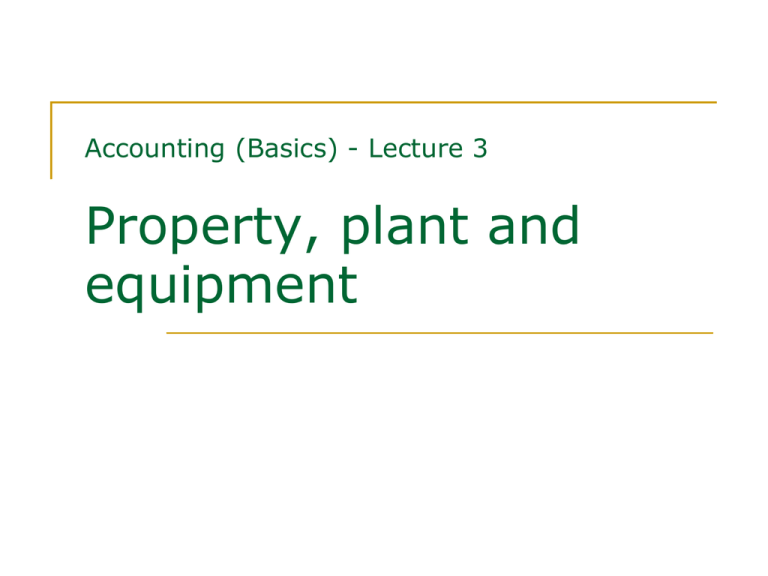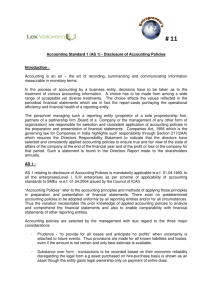***** 1
advertisement

Accounting (Basics) - Lecture 3 Property, plant and equipment Contents Recognition Measurement Depreciation Impairment Derecognition Disclosures Sep 30, 2014 2 Recognition An entity shall recognize the cost of an item of property, plant and equipment as an asset if, and only if: a) it is probable that future economic benefits associated with the item will flow to the entity, and b) the cost of the item can be measured reliably. Spare parts and servicing equipment are usually carried as inventory and recognized in profit or loss as consumed. However, major spare parts and stand-by equipment are property, plant and equipment when an entity expects to use them during more than one period. Similarly, if the spare parts and servicing equipment can be used only in connection with an item of property, plant and equipment, they are considered property, plant and equipment. Parts of some items of property, plant and equipment may require replacement at regular intervals (e.g. the roof of a building). An entity shall add to the carrying amount of an item of property, plant and equipment the cost of replacing part of such an item Oct 5, 2015 3 Recognition when that cost is incurred if the replacement part is expected to provide incremental future benefits to the entity. If the major components of an item of property, plant and equipment have significantly different patterns of consumption of economic benefits, an entity shall allocate the initial cost of the asset to its major components and depreciate each such component separately over its useful life. A condition of continuing to operate an item of property, plant and equipment may be performing regular major inspections for faults regardless of whether parts of the item are replaced. When each major inspection is performed, its cost is recognized in the carrying amount of the item of property, plant and equipment as a replacement if the recognition criteria are satisfied. Any remaining carrying amount of the cost of the previous major inspection (as distinct from physical parts) is derecognized. Land and buildings are separable assets, and an entity shall account for them separately, even when they are acquired Oct 5, 2015 4 together. Measurement – initial and subsequent An entity shall measure an item of property, plant and equipment at initial recognition at its cost. The cost of an item of property, plant and equipment comprises all of the following: a) its purchase price, including legal and brokerage fees, import duties and non-refundable purchase taxes, after deducting trade discounts and rebates. b) any costs directly attributable to bringing the asset to the location and condition necessary for it to be capable of operating in the manner intended by management. These can include the costs of site preparation, initial delivery and handling, installation and assembly, and testing of functionality. c) initial estimate of the costs of dismantling and removing the item and restoring the site on which it is located Oct 5, 2015 5 Initial and subsequent measurement The following costs are not costs of an item of property, plant and equipment, and an entity shall recognize them as an expense when they are incurred: a) costs of opening a new facility. b) costs of introducing a new product or service (including costs of advertising and promotional activities). c) costs of conducting business in a new location or with a new class of customer (including costs of staff training). d) administration and other general overhead costs. e) borrowing costs. The income and related expenses of incidental operations during construction or development of an item of property, plant and equipment are recognized in profit or loss if those operations are not necessary to bring the item to its intended location and operating condition. Oct 5, 2015 6 Measurement - initial and subsequent The cost of an item of property, plant and equipment is the cash price equivalent at the recognition date. If payment is deferred beyond normal credit terms, the cost is the present value of all future payments. An item of property, plant or equipment may be acquired in exchange for a non-monetary asset or assets, or a combination of monetary and non-monetary assets. An entity shall measure the cost of the acquired asset at fair value unless (a) the exchange transaction lacks commercial substance or (b) the fair value of neither the asset received nor the asset given up is reliably measurable. In that case, the asset’s cost is measured at the carrying amount of the asset given up. An entity shall measure all items of property, plant and equipment after initial recognition at cost less any accumulated depreciation and any accumulated impairment losses. An entity shall recognize the costs of day-to-day servicing of an item of property, and equipment in profit or loss in the period when the costs 7 Oct 5,plant 2015 Depreciation If the major components of an item of property, plant and equipment have significantly different patterns of consumption of economic benefits, an entity shall allocate the initial cost of the asset to its major components and depreciate each such component separately over its useful life. Land has an unlimited useful life and therefore is not depreciated. The depreciation charge for each period shall be recognized in profit or loss unless another section of IFRS for SMEs requires the cost to be recognized as part of the cost of an asset. An entity shall allocate the depreciable amount of an asset on a systematic basis over its useful life. Factors such as a change in how an asset is used, significant unexpected wear and tear, technological advancement, and changes in market prices may indicate that the residual value or useful life of an asset has changed since the most recent annual reporting date. If such indicators are present, an entity shall review Oct 5, 2015 8 Depreciation its previous estimates and, if current expectations differ, amend the residual value, depreciation method or useful life. The entity shall account for the change in residual value, depreciation method or useful life as a change in an accounting estimate. Depreciation of an asset begins when it is available for use. Depreciation of an asset ceases when the asset is derecognized. Depreciation does not cease when the asset becomes idle or is retired from active use unless the asset is fully depreciated. However, under usage methods of depreciation the depreciation charge can be zero while there is no production. An entity shall consider all the following factors in determining the useful life of an asset: a) the expected usage of the asset. b) expected physical wear and tear. Oct 5, 2015 9 Depreciation technical or commercial obsolescence arising from changes or improvements in production, or from a change in the market demand for the product or service output of the asset. d) legal or similar limits on the use of the asset, such as the expiry dates of related leases. An entity shall select a depreciation method that reflects the pattern in which it expects to consume the asset’s future economic benefits. The possible depreciation methods include the straightline method, the diminishing balance method and a method based on usage such as the units of production method. If there is an indication that there has been a significant change since the last annual reporting date in the pattern by which an entity expects to consume an asset’s future economic benefits, the entity shall review its present depreciation method and, if current expectations differ, change the depreciation method to reflect the new pattern. The entity shall account for the change as a change in an accounting estimate. c) Oct 5, 2015 10 Impairment At each reporting date, an entity shall apply Section “Impairment of Assets” of IFRS for SMEs to determine whether an item or group of items of property, plant and equipment is impaired and, if so, how to recognize and measure the impairment loss. That section explains when and how an entity reviews the carrying amount of its assets, how it determines the recoverable amount of an asset, and when it recognizes or reverses an impairment loss. An entity shall include in profit or loss compensation from third parties for items of property, plant and equipment that were impaired, lost or given up only when the compensation becomes receivable. A plan to dispose of an asset before the previously expected date is an indicator of impairment that triggers the calculation of the asset’s recoverable amount for the purpose of determining whether the asset is impaired. Oct 5, 2015 11 Derecognition An entity shall derecognize an item of property, plant and equipment: a) on disposal, or b) when no future economic benefits are expected from its use or disposal. An entity shall recognize the gain or loss on the derecognition of an item of property, plant and equipment in profit or loss when the item is derecognized. The entity shall not classify such gains as revenue. In determining the date of disposal of an item, an entity shall apply the criteria in Section “Revenue” of IFRS for SMEs for recognizing revenue from the sale of goods. Section “Revenue” applies to disposal by a sale and leaseback. An entity shall determine the gain or loss arising from the derecognition of an item of property, plant and equipment as the difference between the net disposal proceeds, if any, and the Oct 5, 2015 12 carrying amount of the item. Disclosures An entity shall disclose the following for each class of property, plant and equipment: a) the measurement bases used for determining the gross carrying amount. b) the depreciation methods used. c) the useful lives or the depreciation rates used. d) the gross carrying amount and the accumulated depreciation (aggregated with accumulated impairment losses) at the beginning and end of the reporting period. e) a reconciliation of the carrying amount at the beginning and end of the reporting period showing separately: i. additions ii. disposals iii. acquisitions through business combinations Oct 5, 2015 13 Disclosures transfers to investment property if a reliable measure of fair value becomes available v. impairment losses recognized or reversed in profit or loss vi. depreciation. vii. other changes. This reconciliation need not be presented for prior periods. The entity shall also disclose the following: a) the existence and carrying amounts of property, plant and equipment to which the entity has restricted title or that is pledged as security for liabilities. b) the amount of contractual commitments for the acquisition of property, plant and equipment. iv. Oct 5, 2015 14





